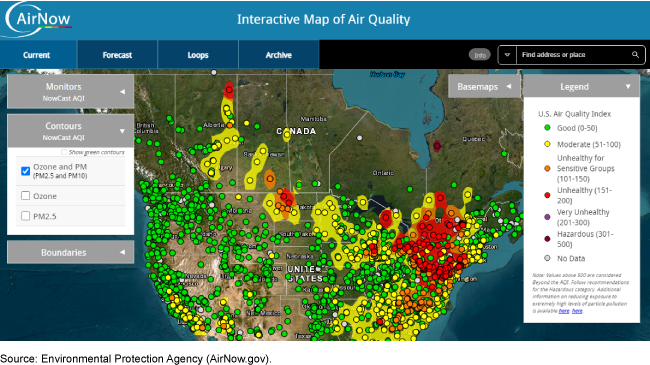Air Pollution: EPA Needs to Develop a Business Case for Replacing Legacy Air Quality Data Systems
Fast Facts
EPA primarily uses two legacy IT systems to manage outdoor air quality data that tribal, state, and local air monitoring agencies collect. Data from these systems helps to identify areas that don't meet air quality standards and communicate information about air pollution levels to the public.
But these aging systems present maintenance and usability challenges for EPA and other users. For example, EPA has had trouble finding IT staff familiar with the outdated software in one of the systems.
EPA is considering replacing these systems with a new one. We recommended that EPA document the need for and cost of a new system to inform this decision.
EPA’s AirNow website, showing near real-time air quality information on June 30, 2023

Highlights
What GAO Found
The Environmental Protection Agency (EPA) primarily uses two legacy IT systems—the Air Quality System (AQS) and AirNow—to manage ambient, that is, outdoor, air quality data collected by the monitoring agencies. These agencies—tribal, state, local, or territorial—design and operate air monitoring sites. EPA developed AQS in 1996 to manage data that are used for regulatory purposes, such as identifying areas that do not meet air quality standards. EPA developed the AirNow system in the late 1990s to provide near real-time information about air pollution levels to the public.
The Environmental Protection Agency's (EPA) AirNow Mobile App

Due to their age and design, AQS and AirNow can be difficult to maintain, access, and use, according to GAO's analysis of EPA and stakeholder views. This limits their functionality and poses resource and other challenges for EPA, monitoring agencies, and other data users. For example, EPA officials said it was particularly challenging to find and retain IT staff with experience or knowledge to work with AQS's outdated software. Moreover, the use of multiple systems to manage air quality data results in inefficient use of resources for EPA and monitoring agencies, according to GAO's analysis of EPA and stakeholder views.
EPA is considering replacing AQS and AirNow with a new, single system to address the legacy system challenges, but progress has been limited partly due to competing priorities and resource limitations, according to EPA officials. Despite listing AQS as a system in need of modernization in 2017, EPA has not clearly identified AQS and AirNow as candidates for replacement through its recent IT management and oversight processes. According to EPA guidance, the agency should assess mature systems to ascertain their continued effectiveness in supporting mission requirements and consider replacement options. However, EPA's processes do not specify factors for evaluating systems that may be ready for replacement, such as if the system has deteriorated beyond economical repair. Identifying factors for consideration could help ensure that EPA identifies such systems and collects information it needs to optimize its resources. Furthermore, EPA has not developed a business case for a new system, which is a step in EPA's IT management process needed to secure management approval for modernizing IT systems or developing a new one. Developing and documenting a business case for a new system could better position EPA to make decisions about whether to replace AQS and AirNow.
Why GAO Did This Study
EPA depends on IT systems to manage air quality data. These data are critical to efforts to reduce air pollution and related public health risks. The data inform regulatory and compliance decisions that have billions of dollars in economic impacts.
Prior GAO work has reported concerns about the antiquated nature of AQS. In addition, EPA listed AQS in a 2017 memorandum as one of its top three mission-critical systems in need of modernization.
GAO was asked to evaluate EPA's IT systems for air quality data. This report examines (1) how EPA uses IT systems to manage air quality data, (2) any challenges these systems present for EPA and other data providers and users, and (3) the extent to which EPA has addressed challenges.
GAO reviewed literature and EPA documents and policies; interviewed EPA officials and six stakeholders from associations of air monitoring agencies and nongovernmental organizations, selected based on their experience providing data to, or using data from, EPA's air quality data systems; and compared EPA efforts with leading practices.
Recommendations
GAO is making three recommendations to EPA, including to identify factors for evaluating IT systems that may be ready for replacement and develop a business case for a new IT system. EPA agreed with two recommendations and disagreed with the one to identify factors for evaluating IT systems. GAO continues to believe identifying such factors could assist with oversight, as discussed in the report.
Recommendations for Executive Action
| Agency Affected | Recommendation | Status |
|---|---|---|
| Environmental Protection Agency | 1. The Assistant Administrator of EPA's Office of Mission Support should identify factors for evaluating whether EPA's IT systems may be ready for replacement or retirement. (Recommendation 1) |
EPA did not agree with this recommendation. We will update the status of this recommendation when we receive additional information from the agency.
|
| Environmental Protection Agency | 2. The Assistant Administrator of EPA's Office of Air and Radiation should consider documenting an operational analysis for AQS and AirNow. (Recommendation 2) |
EPA agreed with this recommendation. We will update the status of this recommendation when we receive additional information from the agency.
|
| Environmental Protection Agency | 3. The Assistant Administrator of EPA's Office of Air and Radiation should develop and document a business case for a new IT system for air quality data based on considerations for how such a system could address the challenges currently posed by AQS and AirNow. The business case should consider an analysis of alternatives, if appropriate. (Recommendation 3) |
EPA agreed with this recommendation. We will update the status of this recommendation when we receive additional information from the agency.
|
